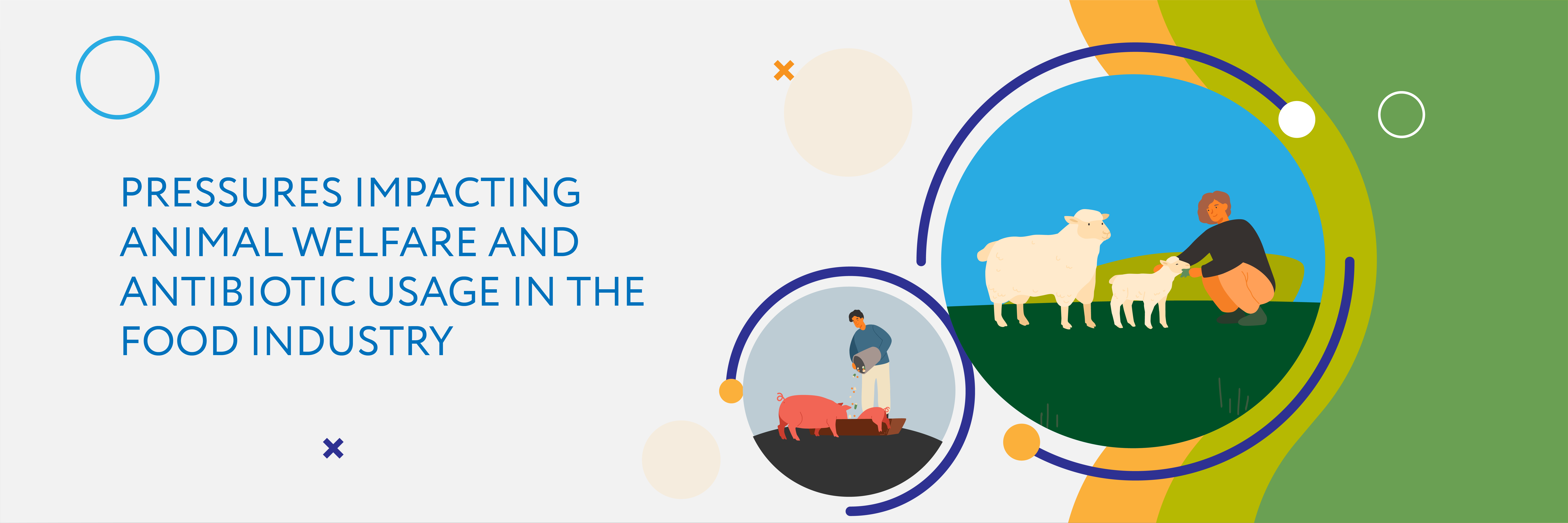
Animal agriculture has always been big business, reports estimating its value varying widely from $90bn and $741bn – the UN Food and Agriculture Organisation finding that livestock makes up about 40% of the global value of agricultural output, supporting the livelihoods and food security of 1.3 billion people.
However, in the modern world, even a mammoth sector such as livestock production is facing a growing number of questions regarding environmental concerns, welfare and use of medication.
Below we will explore the mounting pressures that are bringing animal welfare and antibiotic usage to the forefront of conversations in food industry - from consumer influence to concerns about Anti Microbial Resistance (AMR) and resource shortages.
Changing consumer behaviours to Animal Welfare
Consumers are increasingly concerned about the welfare standards of food producing animals, a recent study revealing that 89% of consumers recognised animal welfare as important to them and their buying habits.
Many consumers have gone as far as to remove animal products from their diet entirely due to concerns regarding the treatment of farm animals with an estimated 720,000 vegans in the UK alone (a 79% increase from 2014) and non-meat sales on the rise at £740 million per year. Although many have vowed to cut down on animal products for health reasons or dietary needs, it was discovered in a recent report that of those who follow a plant-based diet, 55% stated that their motivation was animal welfare with 22% concerned about overuse of Antibiotics.
Obviously, those involved in animal agriculture will not be able to please all plant- based lobbyists, however it is worth noting that of those who consider animal welfare as important, only one in five planned to reduce their meat intake, many being more concerned with improvement of welfare standards, including “free range” and “outdooring rearing” practices I.e. method of production is an important. Stand-alone consideration.
With this growing opinion that farm animal welfare should be protected and improved, pressure is mounting on the food industry to make positive changes to their processes and communicated effectively to consumers.
The Antibiotics Balancing Act
In the case of antibiotic usage, their use on farms is becoming a hot topic and one of increased scrutiny, with many forums gathering to address one of the most pertinent issues of our times.
Antibiotics must be used responsibly and under legislative control, even under conditions of increased production pressure. Those involved in food production must strike a balance between animal welfare needs, treating clinical conditions appropriately while preserving the effectiveness of antibiotics. Particularly those which represent the “last line of defence for human health.”
The risk of AMR (antimicrobial resistance) mustn't be underestimated., The WHO has referred to this issue as a “slow moving pandemic” with 30% of all sepsis deaths in new-born infants linked to antibiotic resistance. By 2050 it is predicted to account for more deaths globally on an annual basis than all combined cancers.
AMR also poses a major risk to sustainable development goals with the World Bank estimating that an extra 28 million people could be forced into extreme poverty by 2050 unless AMR is contained.
Facing a threat of this magnitude, the food industry has been advised to follow the approach of, “As little as possible- as much as necessary.” In practice this means a supported strategy which targets use in a way that promotes animal health and welfare, minimising on-farm loss (and the impact on net sustainability of production) while reducing the potential for the development of antibiotic resistance.
This of course is easier said than done and first requires development and implementation of a meaningful process to capture data allowing for in-depth analysis and comparisons to be drawn between suppliers, sectors, methods of production and different geographies across an increasingly global supply base.

Covid, Brexit and Global Shortages
It would be naive to discuss the pressures impacting animal welfare and the food industry without mentioning Brexit and Covid, both throwing into sharp focus the weaknesses that lie under the surface of the food supply chain and how these issues impact on animal welfare practices.
Although in 2021 we began to see a move back to “normality” after the pandemic, the food industry was quickly met with major shortages and as a result, on-going delays. The lack of skilled workers and resources such as Co2 gas, pose a massive animal health and welfare issue with those involved in production unable to operate within the regulatory standards. Notably the mass culling of pigs due to the lack of trained butchers was both a financial blow to local farms and, a shocking truth for consumers, now faced with the realities of resource shortages in the industry- healthy animals disposed of in order to meet the stringent animal welfare regulations.
The AWC (Animal Welfare Committee) recognised that COVID-19 was the single biggest threat to the welfare of animals at present – its fallout disrupting all fractions within food supply chains. With social distancing and restrictions in place, staff have been unable to receive the required level of training and cannot provide the same level of care.
On top of this, the pandemic has created challenges in transport, breeding, demand, slaughter, supplies and more which in combination of the resource disruptions and mass culling as a result of Brexit has strained animal welfare standards greater than ever before.
In order to recover from such an unpredictable setback, those within the food sector have been advised to build robust contingency plans for the future, with regular tests and updates to reduce the impact. An effective way to achieve this level of foresight is through the implementation of modern software solutions like Foods Connected, specifically designed to give businesses complete visibility and control of their supply network to future proof their animal welfare initiatives. From one centralised system, businesses can manage suppliers, capture their animal welfare activities and compliance, streamline their communications up and down the supply chain and importantly, assess and monitor potential risks to minimise their impact.
Natalie Thorpe
A graduate of Letterkenny Institute of Technology, Natalie studied Visual Communication and Graphic Design. When she's not creating up new designs for company materials and branding, writing, compiling marketing plans or implementing new UX strategies, you'll find her roaming a deserted beach in search of her disappearing dog, or soaking up different cultures on her globetrotting adventures!
Stay up to date
Stay up to date
Browse Posts
- December 2025
- November 2025
- October 2025
- September 2025
- August 2025
- July 2025
- June 2025
- May 2025
- April 2025
- March 2025
- February 2025
- January 2025
- December 2024
- November 2024
- October 2024
- September 2024
- August 2024
- July 2024
- June 2024
- May 2024
- April 2024
- March 2024
- February 2024
- January 2024
- December 2023
- November 2023
- October 2023
- September 2023
- August 2023
- July 2023
- June 2023
- May 2023
- April 2023
- March 2023
- December 2022
- November 2022
- October 2022
- September 2022
- August 2022
- July 2022
- June 2022
- May 2022
- April 2022
- March 2022
- February 2022
- January 2022
- December 2021
- November 2021
- October 2021
- August 2021
/Graphics%20used%20in%20blogs/temple%20grandin%20visit%202024%2003.jpg)
/Blog%20Headers/shutterstock_1927957907%20(1).jpg)
/Blog%20Headers/shutterstock_1845178195%20(2).jpg)
/Blog%20Headers/shutterstock_2133827717%20(1).jpg)
/Blog%20Headers/shutterstock_2473376713.jpg)
/Blog%20Headers/shutterstock_2247276303.jpg)
.png)
.png)




.png)
/Blog%20Headers/shutterstock_2259314129%20(2).jpg)
.png)
.png)
/Blog%20Headers/shutterstock_2084018437.jpg)
/Blog%20Headers/Understanding%20an%20agile%20approach%20to%20product%20lifecycle%20managementjpg.jpg)
.png)
/Blog%20Headers/Preparing%20for%20the%20EU%20Deforestation%20Regulation%20(EUDR)everything%20you%20need%20to%20knowjpg.jpg)